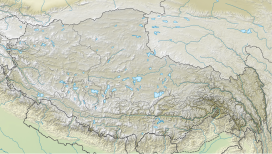| Tanggu La | |
|---|---|
| Chinese: 唐古拉山口 Tánggǔlā Shānkǒu | |
 Tanggu La marker on Qinghai–Tibet Highway | |
| Elevation | 5,072 meters (16,640 ft) (railway) 5,231 meters (17,162 ft) (road) |
| Traversed by | |
| Location | Tibet Autonomous Region and Qinghai Province, China |
| Range | Tanggula Mountains |
| Coordinates | 33°00′39″N 91°39′50″E / 33.010958°N 91.663753°E |
| Tanggula Pass | |||||||
|---|---|---|---|---|---|---|---|
| Chinese name | |||||||
| Traditional Chinese | 唐古拉山口 | ||||||
| Simplified Chinese | 唐古拉山口 | ||||||
| |||||||
| Tibetan name | |||||||
| Tibetan | གདང་ལ | ||||||
| |||||||
The Tanggu La, Tangla Pass, or Tanggu Pass (Chinese: 唐古拉山口; Standard Tibetan: གདང་ལ[1]) is a wide mountain pass in Southwest China over 5,000 meters (16,000 ft) in elevation, used by both the Qinghai–Tibet Highway and Qinghai–Tibet Railway to cross the Tanggula Mountains. These mountains on the Tibetan Plateau separate the Tibet Autonomous Region from the Qinghai province, and also form part of the watershed separating the Yangtze River to the north from a zone of endorheic basins with internal drainage to the south.

The Qinghai–Tibet Highway reaches its highest elevation of 5,231 meters (17,162 ft) in the Tanggu Pass at 32°52′24″N 91°55′03″E / 32.87333°N 91.91750°E. On August 24, 2005, rail track for the Qinghai–Tibet Railway was completed 28 kilometers (17 mi) to the WNW of the highway, reaching 5,072 meters (16,640 ft) at 33°00′38″N 91°39′51″E / 33.01056°N 91.66417°E. The Tanggula railway station 1 km from this summit is the world's highest at 5,068 meters (16,627 ft), 255 meters (837 ft) higher than that of Ticlio, Peru.[2]
The Qinghai–Tibet railway connects the provincial capitals of Xining to Lhasa. The 1,080-kilometer (670 mi)-long section from Golmud to Lhasa was opened on July 1, 2006. The rail cars are equipped with personal oxygen supplies to prevent altitude sickness.
- ^ "Nagqu prefecture-level city (Tibet AR, China)". Institute of the Estonian Language. 2018-06-03. Retrieved 20 July 2020.
Dang La / གདང་ལ bo [bo1963s~; CN_54_1981k; CN_54_1995s:473,Tibt] o21 (54, 63 : Nagqu : Amdo) 32°52′08″N–91°54′55″E → Tanggula Shankou
- ^ "New height of world's railway born in Tibet". Xinhua News Agency. August 24, 2005. Archived from the original on 2005-09-13.


